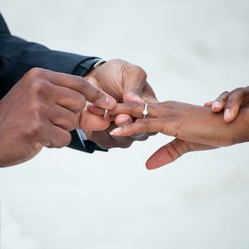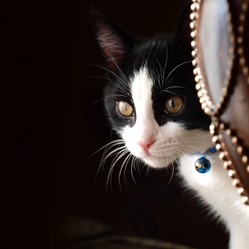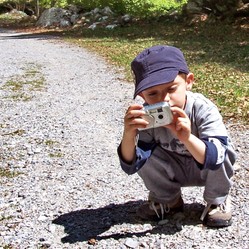Preparations
On being booked to attend a wedding the photographer first notes the date and exact time the ceremony will take place. Also, in his diary will go the name of the church, where the reception is to be held (with, if necessary, road directions), the bride's future name and address and the date of return from the honeymoon. Then he records the style of photograph or wedding album selected and the sum deposited.
If the wedding is not to be a white one the photographer must find out what the bride will be wearing so that he will be able to identify her quickly. (There have been occasions when the wrong person has been photographed!) He will also want to know how long the reception will last and whether the couple will be going away by road, rail, sea or air.
Then the bridal pair need to be briefed on what is expected of them photographically: arriving at the church, outside the church after the service, (the "official" groups will be taken either here or at the reception), at the cake cutting ceremony and as they leave.
Equipment
Over the last ten years or so the technique of wedding photography has undergone many changes, and not just because of technological advances and the move to digital photography, but the major difference being that the posed groups at the studio have been replaced by more informal groups taken either at the church or at the reception. It is also quite common these days to make a complete illustrated story of the occasion.
Flash will be required for all interior shots, so the shutter should be flash synchronized.
Exposure
With white weddings, exposure can be extremely critical. The brightness range between the bride's white gown and the bridegroom's dark suit can be considerable. So when estimating the correct exposure, preferably with a photo-electric exposure meter, particular care should be taken.
If the brightness range is more than the film can handle, exposure should favor the highlights; this is desirable in order to show detail in the bride's gown-more important than the bridegroom's suit.
Arrivals at the Church
The first photographs to be taken are of the arrivals of relatives and friends at the church. As it is impossible to include everyone, the photographer must use his own judgement. Two early arrivals will be the bridegroom and best man and the photographer must be there in time to catch them.
After all the guests have arrived there will be a short lull followed by the arrival of the bridesmaids. They should be given time to get together after the ride and then photographed either actually walking up the path or halted specially for the purpose. There will then be another longer pause.
The next arrival will be the bride who will be escorted into church on the arm of the man who will give her away, usually her father. Here again, they should be allowed a moment or two to compose themselves after getting out of the car before being photographed. Often the photographer will get a better picture by asking them to pause on the church steps. It is very rare for photographs to be taken inside the church during the service, but if such photographs are requested it is essential that permission from the vicar is obtained first. Time exposures are quite suitable as little movement occurs during most of the ceremony.
Care must be taken to avoid making any noise; this applies particularly when using plate cameras with focal plane shutters, which on some models tend to be noisy.
After the Service
While the service is in progress the photographer can be making up his mind on his best place for taking the formal groups. If they are to be taken at the reception then he will only take action shots of the party leaving the church. The light in the porch may not be ideal for photography, but this is undoubtedly the best setting to convey the atmosphere of the ceremony.
With a little tact the photographer can usually manage to get rid of any untidy notices together with any unsightly scraps of paper that may be on the ground. If the sun happens to be shining directly into the porch, it will mean screwed-up faces, but the difficulty can generally be overcome by posing the group in one of the other porches where the lighting is more favorable.
Taking the Groups
The first photograph to be taken is of the bride and bridegroom, particular care being taken to see that the bride holds her bouquet at a becoming angle and that the bridegroom is upright without being wooden, and that his clothes are free from creases. Spectators should not be visible in the background. Two pictures are normally taken, one with the couple looking at the camera and one looking at each other. Their expressions should be pleasant, but broad laughter is best avoided.
The next photograph is of the bride alone, usually half-turned towards the camera with her face looking straight at the lens. She should hold her bouquet gracefully, smile pleasantly, and have her dress and train well arranged around her feet.
The third photograph is the bridal group, ie, bride and bridegroom, best man and bridesmaids. Again particular care should be given to bouquets, hats and trouser creases, as a single fault can make the whole group look foolish.
The last picture consists of the previous group with the addition of the two families on the respective sides of the bridal couple.
Cramping should be avoided and the spectators (and guests not to be included in the group) should be kept tactfully but firmly well out of the way.
Tradition has for so long associated the throwing of confetti with weddings that at least one picture must be secured of the bridal couple undergoing this happy ordeal.
As soon as the last family group has been taken, the photographer should move quickly away ahead of the crowd. He should take up a position from which he can photograph the procession walking down the path to the waiting cars.
For these shots he will of course use a hand camera. Here he will be able to catch the bride and bridegroom covered in confetti entering their car. The photographer should shoot from the "open" side of the car door so that the latter does not obscure the couple. Getting this picture is always a scramble, but it is well worth the effort.
After a final general view for record purposes of the crowd, the church and the cars. the cameraman can follow the bridge and bridegroom and go on to the reception.
At the Reception
There are so many opportunities for securing valuable record pictures at the reception that it pays to carry an electronic flash outfit to save the inconvenience of carrying and disposing of flash bulbs. This should be a powerful portable outfit (100-200 watt-seconds) to provide adequate light even for medium to large size groups.
First the bride and bridegroom are taken receiving their guests; it is as well to take several shots to be sure of getting at least one in which everybody comes out sufficiently clearly and looks happy.
Next, two or three general views of the room should be taken with the guests in their places at the tables.
After the speeches comes the cutting of the cake. This is one of the most popular pictures and the photographer who can be sure of securing one or two happy pictures of this part of the ceremony will be well rewarded. The couple should be carefully posed with knife held by the bride in full view and her hand held by the bridegroom's. It is usual, but not always possible, for the bridesmaid also to appear in this picture. If the table looks untidy a few bouquets placed around the base of the cake will prevent the debris appearing in the pictures.
One or two photographs of the speech making may next be taken. If group photographs have not been possible outdoors, these should also be taken at the reception; for these, extra lighting will certainly be needed.
The last indoor photograph to be taken is of the bride and bridegroom leaving the reception.
Immediately afterwards, the alert cameraman can often capture an unexpected scoop by making his way outside ahead of the couple to photograph the "decoration" of the car.
Finally comes the last photograph of the series as the couple drive away to the accompaniment of waving and cheers.
The Wedding Album
The experienced professional photographer avoids sending out rough proofs; he prepares a complete set of finished photographs and sends them out in a specimen wedding album.
This in its best form is a well presented album in which the photographs are mounted in the order in which they were taken. The first two or three pages are usually reserved and suitably titled to allow details of the wedding to be entered.
With the album goes a price list of both complete albums and individual copies, all prints being plainly numbered to simplify ordering.
A good set of wedding photographs calls for a surprising amount of planning and organization, but it is too serious a task to justify slipshod or careless work. The sincere photographer never loses sight of the fact that he is recording an occasion that his subjects will treasure as a precious memory.













 Photographic Styleon 10/14/2011
Photographic Styleon 10/14/2011
 Interchangeable Lenseson 09/28/2011
Interchangeable Lenseson 09/28/2011
 Negative Blisters and Blemisheson 09/17/2011
Negative Blisters and Blemisheson 09/17/2011
 Photographyon 08/22/2011
Photographyon 08/22/2011


Comments